高中时间状语从句和练习[含答案解析]
高中英语时间状语从句结构单选题40题(含答案)
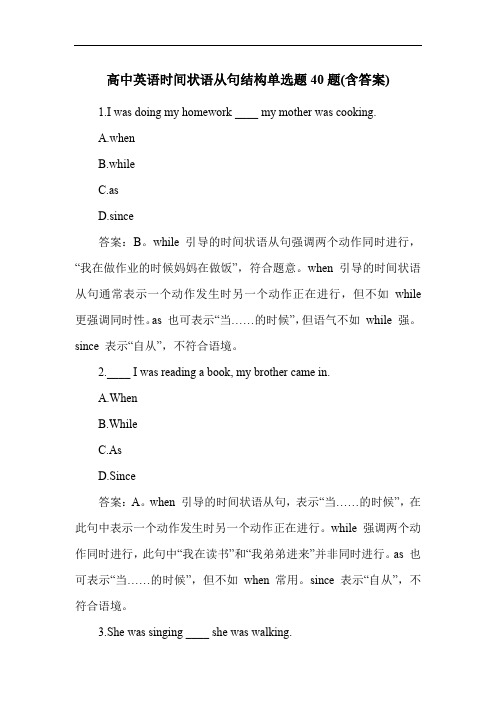
高中英语时间状语从句结构单选题40题(含答案)1.I was doing my homework ____ my mother was cooking.A.whenB.whileC.asD.since答案:B。
while 引导的时间状语从句强调两个动作同时进行,“我在做作业的时候妈妈在做饭”,符合题意。
when 引导的时间状语从句通常表示一个动作发生时另一个动作正在进行,但不如while 更强调同时性。
as 也可表示“当……的时候”,但语气不如while 强。
since 表示“自从”,不符合语境。
2.____ I was reading a book, my brother came in.A.WhenB.WhileC.AsD.Since答案:A。
when 引导的时间状语从句,表示“当……的时候”,在此句中表示一个动作发生时另一个动作正在进行。
while 强调两个动作同时进行,此句中“我在读书”和“我弟弟进来”并非同时进行。
as 也可表示“当……的时候”,但不如when 常用。
since 表示“自从”,不符合语境。
3.She was singing ____ she was walking.A.whenB.whileC.asD.since答案:C。
as 强调两个动作同时进行,“她边走边唱”,符合题意。
when 和while 也可表示“当……的时候”,但as 在此处更强调同时性。
since 表示“自从”,不符合语境。
4.____ he was young, he liked playing football.A.WhenB.WhileC.AsD.Since答案:A。
when 引导的时间状语从句,表示“当……的时候”,在此句中表示“当他年轻时”。
while 强调两个动作同时进行,不符合此语境。
as 也可表示“当……的时候”,但不如when 常用。
since 表示“自从”,不符合语境。
5.I saw him ____ I was going to school.A.whenB.whileC.asD.since答案:A。
时间状语从句讲解和练习(答案)
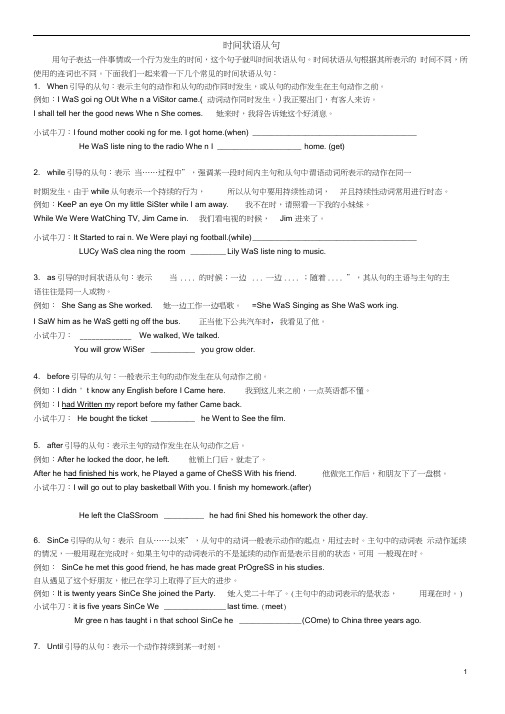
时间状语从句用句子表达一件事情或一个行为发生的时间,这个句子就叫时间状语从句。
时间状语从句根据其所表示的时间不同,所使用的连词也不同。
下面我们一起来看一下几个常见的时间状语从句:1. When引导的从句:表示主句的动作和从句的动作同时发生,或从句的动作发生在主句动作之前。
例如:I WaS goi ng OUt Whe n a ViSitor came.( 动词动作同时发生。
)我正要出门,有客人来访。
I shall tell her the good news Whe n She comes. 她来时,我将告诉她这个好消息。
小试牛刀:I found mother cooki ng for me. I got home.(when) _____________________________________ He WaS liste ning to the radio Whe n I ___________________ home. (get)2. while引导的从句:表示当……过程中”,强调某一段时间内主句和从句中谓语动词所表示的动作在同一时期发生。
由于while从句表示一个持续的行为,所以从句中要用持续性动词,并且持续性动词常用进行时态。
例如:KeeP an eye On my little SiSter while I am away. 我不在时,请照看一下我的小妹妹。
While We Were WatChing TV, Jim Came in. 我们看电视的时候,Jim 进来了。
小试牛刀:It Started to rai n. We Were playi ng football.(while) _____________________________________ LUCy WaS clea ning the room ________ Lily WaS liste ning to music.3. as引导的时间状语从句:表示当.... 的时候;一边... 一边.... ;随着.... ”,其从句的主语与主句的主语往往是同一人或物。
时间状语从句练习题及答案

时间状语从句练习题及答案精品文档时间状语从句练习题及答案由从句担任的状语,在句子中可修饰谓语、形容词、副词或是整个句子,它可以用来表示时间、地点、原因、目的、结果、条件、方式、比较、让步等。
状语从句是一较大的语法项目,也是近几年高考题中常见的一个重要试点。
高考中已考查了时间、让步、地点、条件、目的等状语从句,这些从句仍是今后高考热点,应作充分准备。
同时对方式状语从句也应引起重视。
时间状语从句表示时间的状语从句可由when, as, while, whenever, after, before,till , since, once, as soon as , by the time, no sooner … than, hardly … when, every time等引导。
e.g. When I came into the office, the teachers were having a meeting.He started as soon as he received the news. Once you see him, youwill never forget him. No sooner had I gone to bed than I went to sleep.原因状语从句原因状语从句是表示原因或理由的,引导这类从句的最常用的连词是because, since, as , now that等,for 表示因果关系时为并列连词,语气不如because强。
e.g. He is disappointed because he didn’t get1 / 23精品文档the position.As it is raining, I will not go out. Now that you mention it, I do remember.地点状语从句引导地点状语从句的连词是where 和wherever等。
时间状语从句(含练习及答案)

以when 引导的时间状语从句- When I got home, my son had finished his homework. (主句动作发生在从句之前)- When(当...时候, 主语+did) we arrived, it was raining.- When(正当...时候,主语+be+doing) I was playing the computer games, my mum came in. - He is always nervous when he speaks to strangers.- I usually walk to school when it rains.以while 引导的时间状语从句- While I was reading, my brother was playing with his toy cars. (主从句子动作同时发生)- While/When/As he was studying in the library, I saw him. (表示一段时间时,while/when/as 可替换)while引导的从句的谓语动词必须是持续性动作:I saw him while(x) I was getting off the bus.(x)I saw him when/as I was getting off the bus.以as 引导的时间状语从句- He will grow wiser as he grows older. 随着年龄的增长,他会聪明起来。
(随着,表示时间的推移,这时,不用when/while)- He entered the room as/when/while the meeting was going on. 正当开会的时候,他走进房间。
以before引导的时间状语从句- He had washed his hands before he had dinner. (主句动作先于从句动作)- Please clean the house before you move in.以after 引导的时间状语从句- She went on holiday after she had taken the examination. (从句动作先于主句)- You can watch TV after you finish your homework.以since 引导的时间状语从句- She has been in the house since she came to the city. (主句完成时态,从句过去时)- I have taught them English since last year.以as soon as引导的时间状语从句- I will write to you as soon as I get to America. 我一到美国就会给你写信。
高三英语状语从句练习题30题含答案解析

高三英语状语从句练习题30题含答案解析1. I was reading a book when suddenly the lights went out.A. whenB. whileC. asD. since答案解析:A。
“when”在这里表示“就在这时”,强调一个动作正在进行的时候另一个动作突然发生。
“while”通常强调两个动作同时进行,这里不合适。
“as”也有当……的时候的意思,但语气没有“when”强烈。
“since”表示自从,不符合语境。
2. She had just fallen asleep when the phone rang.A. whenB. whileC. asD. until答案解析:A。
“when”在此处表示一个动作刚发生另一个动作紧接着发生。
“while”一般用于两个动作同时进行。
“as”也有类似的意思,但不如“when”常用。
“until”表示直到……才,与语境不符。
3. I was taking a shower as he came in.A. asB. whenC. while答案解析:A。
“as”表示当……的时候,强调两个动作同时发生。
“when”也有当……的时候的意思,但在这里不如“as”贴切。
“while”强调两个动作同时持续进行。
“since”表示自从,不合适。
4. He was watching TV when his friend arrived.A. whenB. whileC. asD. after答案解析:A。
“when”表示一个动作正在进行时另一个动作突然发生。
“while”强调两个动作同时进行。
“as”也可表示当……的时候,但这里用“when”更自然。
“after”表示在……之后,不符合语境。
5. I had just finished my homework when my mom came back.A. whenB. whileC. asD. before答案解析:A。
高中英语状语从句讲解和练习(含答案)
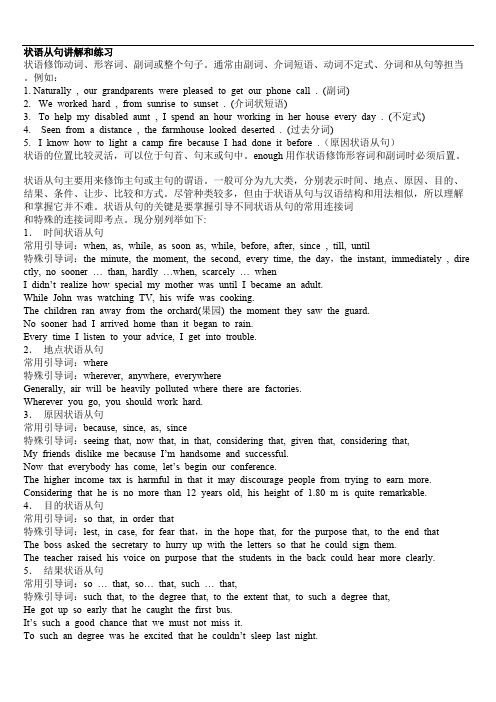
状语从句讲解和练习状语修饰动词、形容词、副词或整个句子。
通常由副词、介词短语、动词不定式、分词和从句等担当。
例如:1. Naturally , our grandparents were pleased to get our phone call . (副词)2. We worked hard , from sunrise to sunset . (介词状短语)3. To help my disabled aunt , I spend an hour working in her house every day . (不定式)4. Seen from a distance , the farmhouse looked deserted . (过去分词)5. I know how to light a camp fire because I had done it before .(原因状语从句)状语的位置比较灵活,可以位于句首、句末或句中。
enough用作状语修饰形容词和副词时必须后置。
状语从句主要用来修饰主句或主句的谓语。
一般可分为九大类,分别表示时间、地点、原因、目的、结果、条件、让步、比较和方式。
尽管种类较多,但由于状语从句与汉语结构和用法相似,所以理解和掌握它并不难。
状语从句的关键是要掌握引导不同状语从句的常用连接词和特殊的连接词即考点。
现分别列举如下:1.时间状语从句常用引导词:when, as, while, as soon as, while, before, after, since , till, until特殊引导词:the minute, the moment, the second, every time, the day,the instant, immediately , dire ctly, no sooner … than, hardly …when, scarcely … whenI didn’t realize how special my mother was until I became an adult.While John was watching TV, his wife was cooking.The children ran away from the orchard(果园) the moment they saw the guard.No sooner had I arrived home than it began to rain.Every time I listen to your advice, I get into trouble.2.地点状语从句常用引导词:where特殊引导词:wherever, anywhere, everywhereGenerally, air will be heavily polluted where there are factories.Wherever you go, you should work hard.3.原因状语从句常用引导词:because, since, as, since特殊引导词:seeing that, now that, in that, considering that, given that, considering that,My friends dislike me because I’m handsome and successful.Now that everybody has come, let’s begin our conference.The higher income tax is harmful in that it may discourage people from trying to earn more. Considering that he is no more than 12 years old, his height of 1.80 m is quite remarkable.4.目的状语从句常用引导词:so that, in order that特殊引导词:lest, in case, for fear that,in the hope that, for the purpose that, to the end thatThe boss asked the secretary to hurry up with the letters so that he could sign them.The teacher raised his voice on purpose that the students in the back could hear more clearly.5.结果状语从句常用引导词:so … that, so… that, such … that,特殊引导词:such that, to the degree that, to the extent that, to such a degree that,He got up so early that he caught the first bus.It’s such a good chance that we must not miss it.To such an degree was he excited that he couldn’t sleep last night.6.条件状语从句常用引导词:if, unless,特殊引导词:as/so long as, only if, providing/provided that, suppose that, in case that, on condition th atWe’ll start our project if the president agrees.You will certainly succeed so long as you keep on trying.Provided that there is no opposition, we shall hold the meeting here.7.让步状语从句常用引导词:though, although, even if, even though特殊引导词:as(用在让步状语从句中必须要倒装),while ( 一般用在句首),no matter …,in spite of the fact that, while, whatever, whoever, wherever, whenever, however, whicheverMuch as I respect him, I can’t agree to his proposal.尽管我很尊敬他,我却不同意他的建议。
时间状语从句及其练习题

状语从句一、时间状语从句一、时间状语从句 1、 as soon as “一、、、、、、就、、、、、、”引导时间状语从句的连词有引导时间状语从句的连词有The moment immediately The minute directly He instant instantly No sooner than Hardly had sb , done done…… when ….did ….. Scarcely when The moment she comes, I’I’ll call you. ll call you. She left immediately the meeting was over. Hardly had he got off the bus when he heard a loud noise. 2、 when ,while , as 引导时间状语从句引导时间状语从句时间点时间点 段时间段时间 区 别 When 主从同时;先后主从同时;先后 While 主从同时主从同时 对比对比 As 主从同时主从同时(一边、、、一边)、一边)It was raining when we arrived. My mother came in when I was doing my homework. While /when I was doing my homework, my mother came in. I am safe while I am here. He hurried home, looking behind as he went. As I left the house, I forgot the key. 主从句时态主从句时态Will you please bring me your book when you come here tomorrow? I will go home when I have finished my work . When / while 连词引导并列句连词引导并列句Was/ were about to do …Was /were going to do …. Was/were on one ’s way …Was .were on the point of doing …. When …. Was/were doing Was/were doing……. (“这时” 表同时) Had done …Jasmine was holidaying holidaying with with with her her her family family family in in in a wildlife a wildlife park when she w as was was bitten bitten bitten on on on the the the leg leg leg by by by a a lion. ………….while .while ………….(.(“然而”“然而” 表反比) I do every single bit of housework while my husband Bob just does the dishes now and then. 3、before 引导时间状语从句引导时间状语从句1)“还没等”(谓语不用否定式)(谓语不用否定式)Before they got to the bus stop, the bus had gone. 2) “….. (之后)才/就”It was evening before we reached the little town of Winchester. 3)固定句型:固定句型: It will (not) be some time before …………do do …… It was (not) some time before ….did ….. It won ’t be long before …………dodo do............ It wasn ’t long before (i)did did…….. 4 . until /till ( till 不用于句首或强调句)不用于句首或强调句) 引导时间状语从句引导时间状语从句1)…..not ….until/till .until/till……直到……才 He didn ’t go to bed until he had finished his work 2) …...until …...until /till /till …..直到……为止为止We were told that we should follow the main road until we reached the railway station . 3)强调句式强调句式It is not until …that … It was not until midnight that he went back home after the experiment. 4) not until 放在句首时,主句半倒装。
高考英语语法必考考点(12)状语从句(含解析)
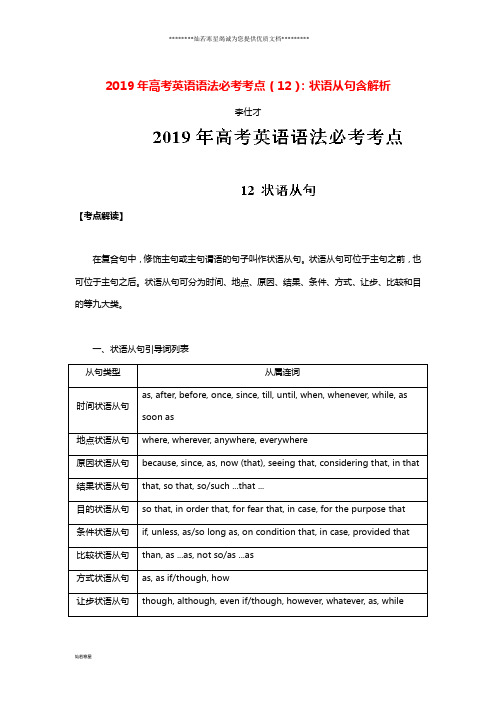
2019年高考英语语法必考考点(12):状语从句含解析李仕才【考点解读】在复合句中,修饰主句或主句谓语的句子叫作状语从句。
状语从句可位于主句之前,也可位于主句之后。
状语从句可分为时间、地点、原因、结果、条件、方式、让步、比较和目的等九大类。
一、状语从句引导词列表从句类型从属连词时间状语从句as, after, before, once, since, till, until, when, whenever, while, as soon as地点状语从句where, wherever, anywhere, everywhere原因状语从句because, since, as, now (that), seeing that, considering that, in that 结果状语从句that, so that, so/such ...that ...目的状语从句so that, in order that, for fear that, in case, for the purpose that条件状语从句if, unless, as/so long as, on condition that, in case, provided that 比较状语从句than, as ...as, not so/as ...as方式状语从句as, as if/though, how让步状语从句though, although, even if/though, however, whatever, as, while【点睛】(1)上述有些连词除了能引导状语从句外,还可引导定语从句和名词性从句。
在使用的时候,要根据句子结构和句意来判别和区分不同的从句,正确使用引导词。
以where为例,试比较下列多种从句的区别。
You are to find it where you left it. (地点状语从句)Tell me the address where he lives. (定语从句,先行词为the address)I don’t know where he came from. (宾语从句)Where he has gone is not known yet. (主语从句)This place is where they once hid. (表语从句)(2)在两个分句间要有一个且只有一个连词,千万不能按汉语习惯。
【语法专项训练】状语从句翻译专项练习及答案
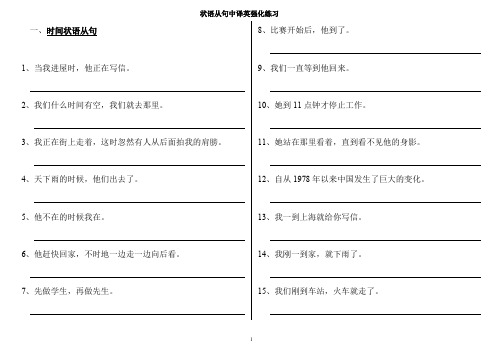
一、时间状语从句1、当我进屋时,他正在写信。
2、我们什么时间有空,我们就去那里。
3、我正在街上走着,这时忽然有人从后面拍我的肩膀。
4、天下雨的时候,他们出去了。
5、他不在的时候我在。
6、他赶快回家,不时地一边走一边向后看。
7、先做学生,再做先生。
8、比赛开始后,他到了。
9、我们一直等到他回来。
10、她到11点钟才停止工作。
11、她站在那里看着,直到看不见他的身影。
12、自从1978年以来中国发生了巨大的变化。
13、我一到上海就给你写信。
14、我刚一到家,就下雨了。
15、我们刚到车站,火车就走了。
16、我们刚开始就被叫停。
17、我每次乘船都晕船。
18、我一听到这首歌,就感到很愉快。
19、下次你来的时候,就会见到他。
二、地点状语从句1、有志者,事竟成。
2、哪里有水,哪里就有生命。
3、你可以随意到你喜欢的任何地方去。
4、无论你去哪都要遵守法律。
三、原因状语从句1、昨天我回来晚了,因为我值班。
2、既然大家都到了,我们开始开会。
3、由于他英语懂得不多,他在字典中查阅这个单词。
4、鉴于天气已经晴朗,我们可以启程了。
5、鉴于他病情严重,我们派人去请医生去了。
四、目的状语从句1、我要把你的电话号码记下来,以免忘记。
2、我把真实情况告诉你,使你能自己作出判断。
3、他们比往常更加努力工作,为了能提前完成工作。
4、多穿点衣服,以免患感冒。
五、结果状语从句1、我们把收音机的音量放大,大家都听到了新闻。
2、他十分激动,以致一句话都说不出来。
3、他说出了这么重要的理由,得到大家的谅解。
4、这是一本十分有意思的书,大家都想看。
六、条件状语从句1、如果我们不怕困难,困难就算不了什么了。
2、除非下雨,我们明天就去那里。
3、只要你努力工作,你就一定能成功。
4、万一我忘了,请提醒我一下。
5、据我所知,那本书下月出版。
七、方式状语从句1、按照我教你的画一只猫。
2、按照人家告诉你做的去做。
3、看上去她好象是生病了。
4、他的行动就好象什么也没有发生。
(完整版)高考英语专题复习状语从句(附答案)

高考英语专题复习状语从句(附答案)I. 考点分析状语从句可用来表示时间、地点、原因、目的、结果、条件、方式、比较和让步等。
1.时间状语从句1) 常见关联词有when, whenever, while, as, before, after 等。
2)注意not…until… 正常结构、倒装结构、强调结构、和until置于句首的用法。
He didn’t go to sleep until he had finished his homework. (正常结构)Not until he had finished his homework did he go to sleep. (倒装结构)It was not until he had finished his homework that he went to sleep.(强调结构)Until he had finished his homework he didn’t go to sleep. (until置于句首)3)表示“一……就……”的连词:once, as soon as, hardly/scarcely…when, no sooner…than, the minute, the moment, the instant, immediately, directly, instantly4)其他表示时间的短语还有:every time, next time, the day 等。
2.地点状语从句通常由where, wherever引导如:Where there is a will, there is a way.3.原因状语从句1) 通常由because, as ,since引导, 三者区别:because 语气最强,重在交待原因,以why引导的疑问句只能because用来回答;其前可用only, just等词强调;可用在It is…that…强调句型中。
高三英语时间状语从句单选题50题

高三英语时间状语从句单选题50题1. I was reading a novel ____ the power went out.A. whenB. whileC. asD. during答案:A。
解析:when表示“当……的时候”,既可以指时间点,也可以指时间段,从句中的动作可以先于主句动作发生,也可以同时发生。
在此句中,“我正在读小说”这个动作在进行过程中突然发生了“停电”这个动作,这里强调的是一个动作(停电)发生的瞬间,所以用when。
while强调主句和从句的动作同时进行,且从句的动词一般是延续性动词,这里停电是瞬间动作,所以B不合适。
as表示两个动作同时进行,常表示“一边……一边……”,在这里不符合语境,C不对。
during是介词,不能引导从句,D错误。
2. ____ I was walking in the park, I saw an old friend.A. WhenB. WhileC. AsD. Since答案:B。
解析:while强调主句和从句动作同时进行,这里“我在公园散步”和“看到老朋友”这两个动作是同时发生的,且walk是延续性动词,所以用while比较合适。
when虽然也可以表示两个动作同时发生,但更强调动作发生的时间点。
as更多的表示“随着”“一边……一边……”的意思,在这里不太符合语境。
since表示“自从”或者“因为”,不符合句子意思,所以A、C、D错误。
3. She sang ____ she worked.A. whenB. whileC. asD. for答案:C。
解析:as表示两个动作同时进行,有“一边……一边……”的意思,在这里表示她一边工作一边唱歌。
when更多强调时间点或者一个动作发生在另一个动作期间。
while强调动作同时进行时,从句动词一般是延续性动词,这里虽然work是延续性动词,但as更能体现出同时进行的伴随状态。
for表示原因或者目的,不符合句子意思,所以A、B、D错误。
高中英语时间状语从句完形填空题30题答案解析版
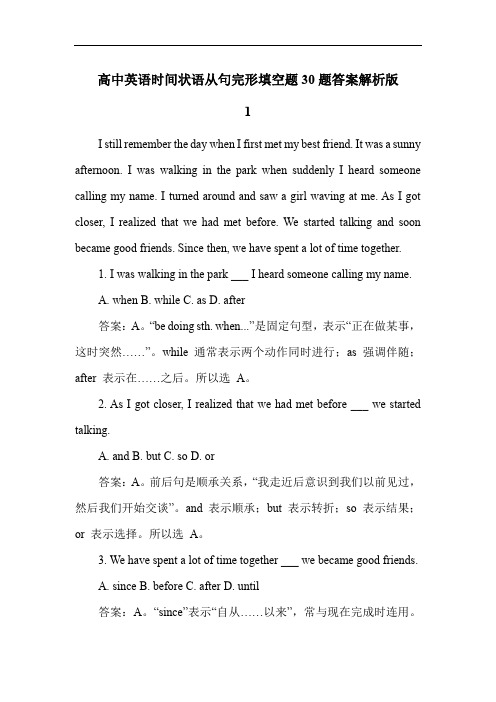
高中英语时间状语从句完形填空题30题答案解析版1I still remember the day when I first met my best friend. It was a sunny afternoon. I was walking in the park when suddenly I heard someone calling my name. I turned around and saw a girl waving at me. As I got closer, I realized that we had met before. We started talking and soon became good friends. Since then, we have spent a lot of time together.1. I was walking in the park ___ I heard someone calling my name.A. whenB. whileC. asD. after答案:A。
“be doing sth. when...”是固定句型,表示“正在做某事,这时突然……”。
while 通常表示两个动作同时进行;as 强调伴随;after 表示在……之后。
所以选A。
2. As I got closer, I realized that we had met before ___ we started talking.A. andB. butC. soD. or答案:A。
前后句是顺承关系,“我走近后意识到我们以前见过,然后我们开始交谈”。
and 表示顺承;but 表示转折;so 表示结果;or 表示选择。
所以选A。
3. We have spent a lot of time together ___ we became good friends.A. sinceB. beforeC. afterD. until答案:A。
高中时间状语从句和练习[含答案解析]
![高中时间状语从句和练习[含答案解析]](https://img.taocdn.com/s3/m/5e63ecd2941ea76e58fa04c1.png)
状语从句状语从句在句中作状语,修饰主句中的动词、形容词或副词等。
状语从句放在主句之前时,常用逗号分开;放在主句之后,一般不用逗号。
状语从句按其意义和作用可分为时间、原因、地点、条件、让步、目的、结果、方式、比较等9种。
1.时间状语从句时间状语从句表示主句动作发生的时间,主要由when,while,as ; before, after; till (until); once, by the time, as soon as, no sooner ... than和hardly ... when及名词词组the moment等引导。
1) when“在……的时候”; while “在……期间”; as “正当……的时候”when意为“在……的时候”,强调“特定时间”。
When spring came, he felt like a trip.When he was eating his breakfast, he heard the doorbell ring.说明:连词when在状语从句中还有如下几种含义:①表示突然发生的事,含义为“(正在……时)忽然”。
I was just coming along to see you when I ran into Wilson.I had been working a couple of months when I had a letter from Jane.②表示过早发生某事,意为“(还没……)就”。
此含义有时可用before代替。
I hadn’t been reading for half an hour when I heard steps outside.我刚读了不到半个小时就听到外面有脚步声。
I had been there little more than a week when I set to work in earnest.③表示“在……的情况下”,常可译为“虽然”,“既然”,“如果”。
高中英语状语从句练习与讲解含答案
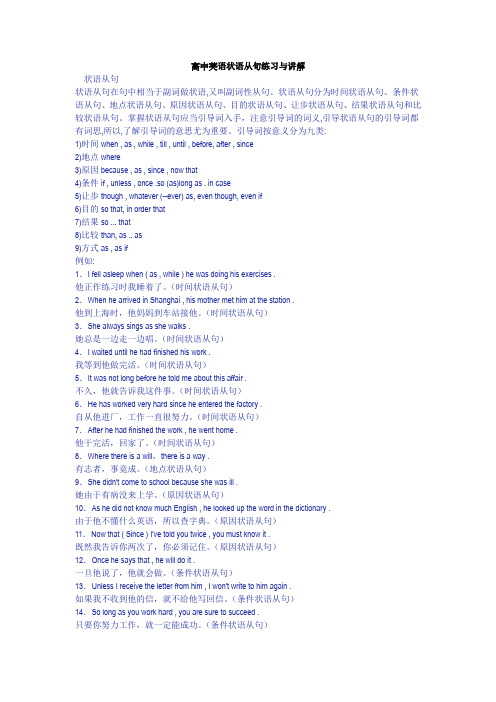
高中英语状语从句练习与讲解状语从句状语从句在句中相当于副词做状语,又叫副词性从句。
状语从句分为时间状语从句、条件状语从句、地点状语从句、原因状语从句、目的状语从句、让步状语从句、结果状语从句和比较状语从句。
掌握状语从句应当引导词入手,注意引导词的词义,引导状语从句的引导词都有词思,所以,了解引导词的意思尤为重要。
引导词按意义分为九类:1)时间when , as , while , till , until , before, after , since2)地点where3)原因because , as , since , now that4)条件if , unless , once .so (as)long as . in case5)让步though , whatever (--ever) as, even though, even if6)目的so that, in order that7)结果so ... that8)比较than, as .. as9)方式as , as if例如:1.I fell asleep when ( as , while ) he was doing his exercises .他正作练习时我睡着了。
(时间状语从句)2.When he arrived in Shanghai , his mother met him at the station .他到上海时,他妈妈到车站接他。
(时间状语从句)3.She always sings as she walks .她总是一边走一边唱。
(时间状语从句)4.I waited until he had finished his work .我等到他做完活。
(时间状语从句)5.It was not long before he told me about this affair .不久,他就告诉我这件事。
(时间状语从句)6.He has worked very hard since he entered the factory .自从他进厂,工作一直很努力。
英语时间状语从句讲解与练习(完整版)
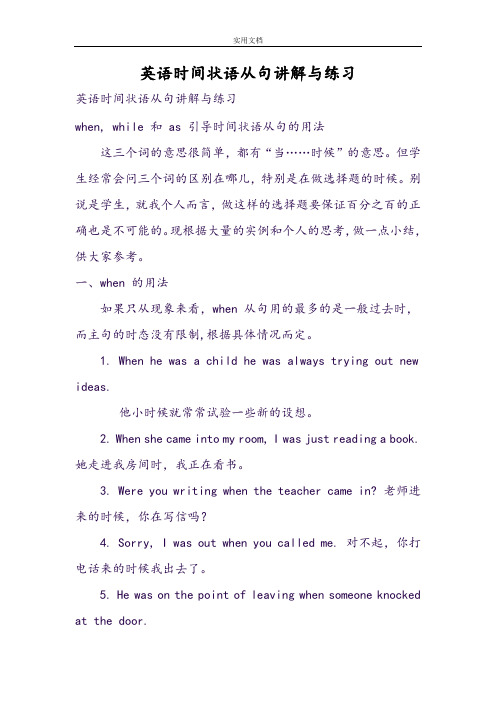
英语时间状语从句讲解与练习英语时间状语从句讲解与练习when, while 和 as 引导时间状语从句的用法这三个词的意思很简单,都有“当……时候”的意思。
但学生经常会问三个词的区别在哪儿,特别是在做选择题的时候。
别说是学生,就我个人而言,做这样的选择题要保证百分之百的正确也是不可能的。
现根据大量的实例和个人的思考,做一点小结,供大家参考。
一、when 的用法如果只从现象来看,when 从句用的最多的是一般过去时,而主句的时态没有限制,根据具体情况而定。
1. When he was a child he was always trying out new ideas.他小时候就常常试验一些新的设想。
2. When she came into my room, I was just reading a book. 她走进我房间时,我正在看书。
3. Were you writing when the teacher came in? 老师进来的时候,你在写信吗?4. Sorry, I was out when you called me. 对不起,你打电话来的时候我出去了。
5. He was on the point of leaving when someone knocked at the door.他正要走,这时有人敲门。
6. I thought of it just when you opened your mouth. 就在你要说话的时候,我也想到了。
7. I had hardly[scarcely] closed my eyes when someone knocked at the door.我刚一闭上眼,就有人在敲门了。
根据以上的例句,我们可以总结出一点:when 从句的A事件,相当于另一个事件B发生的时间点。
也就是说,when 从句的重点不在动作本身发生的状态,而只是把它作为一个时间点,所以when 多数情况下用的是一般过去时,则不用正在进行时。
时间状语从句+习题练习(含答案)
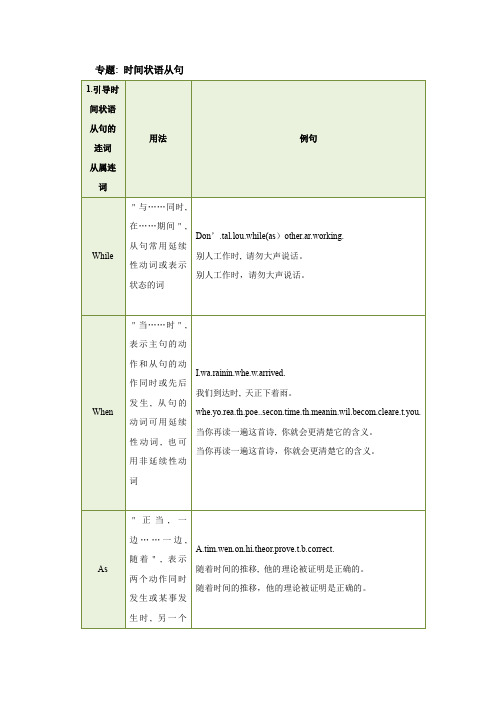
专题: 时间状语从句在下列空格中填入适当连词。
1._________he comes tomorrow,I will ask where he has been.2._________he was speaking,everybody listened carefully.3.I saw her just now_________she was getting off the train.4.Have a good look at that man________you pass him.5.It was already eight o'clock_________we got there.6.I was about to go out_________a visitor came.7.We'll go to the country at the beginning of June,_________the summer harvest will start.8.He learned to speak German_________he was in Berlin.9.Henry is in charge of the office________Mr.Smith is away.10.I listen to the recorder_________I have time.11.He had learned Chinese_________he came to China.12._________the work was done,we sat down to sum up experience.13.I haven't seen him_________he moved to the other side of the town.14.I waited________ he came back.15.I didn’t recognize him________he took off his eyeglasses.16.She likes everything to be in place________she starts to work.17.The thieves ran away_________they caught sight of the police.18.They decided to go back home_________their money ran out.19.__________I get to the airport,I will phone you to pick me up.20.They were about to leave______it began to rain.Keys:1.When2.While/When3.as4.when/as5.when6.when7.when8.while9.whi le10.whenever11.before12.After13.since14.till/until15.until16.before17.as soon as18.before19.As soon as20.when。
状语从句[含练习和答案解析]
![状语从句[含练习和答案解析]](https://img.taocdn.com/s3/m/4f79b1a6eefdc8d376ee32f5.png)
第十二讲状语从句(含练习与答案)担任状语的从句叫状语从句,可以用来表示时间、地点、原因、目的、结果、条件、方式、比较、让步等。
一、时间状语从句:引导词有after,before,as,once,since,till,until,when,whenever,while,as soon as,the moment/minute…(一…就),the time, the day, every time, next time, each time,by the time ,no sooner…than(一…就),hardly(scarcely)…when(一…就)immediately/directly等.Each/Every time he comes here, he will drop in on me.He was ill last time I saw him.上次我见到他时他病了.Hardly had I got to the office when my wife phoned me to go back home at once.=No sooner had I got to the office than my wife phoned me to go home at once.I recognized him immediately I saw him.※ when, while与 as当主句动作时瞬时的,从句动作是延续的,三者都可以用。
when引导的从句动词可以是延续性的或短暂性的,在“be…when…”句式中when表“at that time(就在这时)”意。
while引导的从句中动词必须是延续性的;有时并不表示时间,而表示对比,意“而”、“却”,并列连词,表对照。
As 强调主、从句动作同时或几乎同时发生,意为“一边…一边…”。
When I got home I found the door locked.While / When / as we were working in the fields, it suddenly began to rain.He was wandering through the streets when a bike hit him.I was about to go out when the telephone rang.I had just arrived at school when my wife phoned me to go home.His pencil is red, while mine is yellow.John sang happily as he went along.※ till与until一般情况下可以互换,但until可以位于句首,till则不能。
高中英语状语从句讲解及练习(含答案)
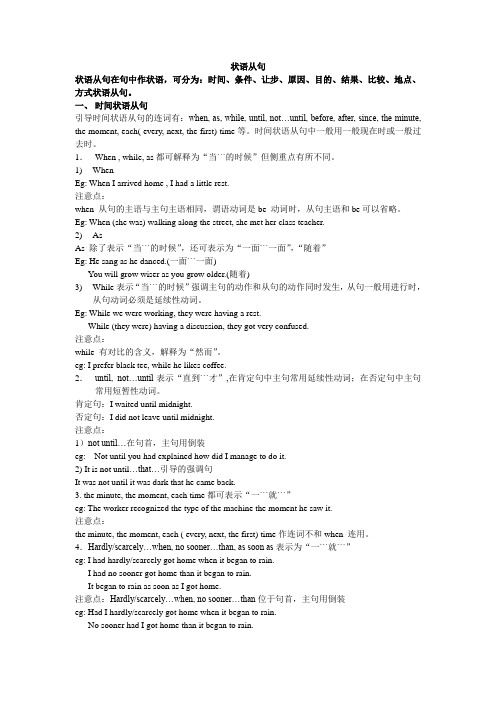
状语从句状语从句在句中作状语,可分为:时间、条件、让步、原因、目的、结果、比较、地点、方式状语从句。
一、时间状语从句引导时间状语从句的连词有:when, as, while, until, not…until, before, after, since, the minute, the moment, each( every, next, the first) time等。
时间状语从句中一般用一般现在时或一般过去时。
1.When , while, as都可解释为“当```的时候”但侧重点有所不同。
1)WhenEg: When I arrived home , I had a little rest.注意点:when 从句的主语与主句主语相同,谓语动词是be 动词时,从句主语和be可以省略。
Eg: When (she was) walking along the street, she met her class teacher.2)AsAs 除了表示“当```的时候”,还可表示为“一面```一面”,“随着”Eg: He sang as he danced.(一面```一面)You will grow wiser as you grow older.(随着)3)While表示“当```的时候”强调主句的动作和从句的动作同时发生,从句一般用进行时,从句动词必须是延续性动词。
Eg: While we were working, they were having a rest.While (they were) having a discussion, they got very confused.注意点:while 有对比的含义,解释为“然而”。
eg: I prefer black tee, while he likes coffee.2.until, not…until表示“直到```才”,在肯定句中主句常用延续性动词;在否定句中主句常用短暂性动词。
- 1、下载文档前请自行甄别文档内容的完整性,平台不提供额外的编辑、内容补充、找答案等附加服务。
- 2、"仅部分预览"的文档,不可在线预览部分如存在完整性等问题,可反馈申请退款(可完整预览的文档不适用该条件!)。
- 3、如文档侵犯您的权益,请联系客服反馈,我们会尽快为您处理(人工客服工作时间:9:00-18:30)。
状语从句状语从句在句中作状语,修饰主句中的动词、形容词或副词等。
状语从句放在主句之前时,常用逗号分开;放在主句之后,一般不用逗号。
状语从句按其意义和作用可分为时间、原因、地点、条件、让步、目的、结果、方式、比较等9种。
1.时间状语从句时间状语从句表示主句动作发生的时间,主要由when,while,as ; before, after; till (until); once, by the time, as soon as, no sooner ... than和hardly ... when及名词词组the moment等引导。
1) when“在……的时候”; while “在……期间”; as “正当……的时候”when意为“在……的时候”,强调“特定时间”。
When spring came, he felt like a trip.When he was eating his breakfast, he heard the doorbell ring.说明:连词when在状语从句中还有如下几种含义:①表示突然发生的事,含义为“(正在……时)忽然”。
I was just coming along to see you when I ran into Wilson.I had been working a couple of months when I had a letter from Jane.②表示过早发生某事,意为“(还没……)就”。
此含义有时可用before代替。
I hadn’t been reading for half an hour when I heard steps outside.我刚读了不到半个小时就听到外面有脚步声。
I had been there little more than a week when I set to work in earnest.③表示“在……的情况下”,常可译为“虽然”,“既然”,“如果”。
She refuses help when (although) she has many friends.Why do you walk when (since) you have a car?How can I help them to understand when (if) they won’t liste n to me.④后接虚拟结构,含义为“本可以,应该……”。
He stopped trying when he might have succeeded next time.They were playing when they could have been working.while意为“在……期间”,从句用持续性动词,表时间的一段,而不是一点。
While he was eating his breakfast, he heard the doorbell ring.We must strike while the iron is hot.说明:连词while在状语从句中还有如下几种含义:①意为“然而,但是”,表示前后对照,说明两种情况相反Tom is very outgoing, while Jane is shy and quiet.Some people waste food while others haven’t enough.②意为“虽然,尽管”(多放句首),从句和主句主语多为同一人或物。
While I understand what you say, I can’t agree with you.While forbidden fruit is said to taste sweeter, it usually spoils faster.虽然有人说禁果的味道更甜,但它腐烂得也更快。
③意为“只要”。
参看while引导条件状语从句。
as意为“正当”,强调同一时间里两个相继发生或变化的情况,或两个动作一前一后,有时有“随着……”的含义。
As he was eating his breakfast, he heard the doorbell ring. (强调同一时间)As I was going out, it began to rain.(强调两个动作先后发生)As spring warms the good earth, all flowers begin to bloom. (as 有“随着”的含义)2) before “在……之前”,after “在……之后”强调事件的先后关系before表示两件事的先后关系。
主句为肯定句,before引导的从句动作后发生;主句为否定句,before引导的从句动作先发生。
I started my meal before he arrived. (从句动作后发生)He didn’t arrive before I returned. (从句动作先发生)说明:在不同的结构中,连词before在状语从句中有如下几种含义。
①意为“…………(之后)才”,此结构主句常用肯定式,强调主句内容持续的色彩。
It will be ten years before we meet again. 要10年后我们才能再见面。
It was evening before we reached that little town.傍晚时分我们才到达那个小镇。
②意为“(不久)…………就”,用“...not long before”这一结构,强调时间的短暂It won’t be long before you regret.不久你就会后悔的。
It wasn’t long before he told me about this affair.不久他就把这事告诉我了。
③意为“不等/没有……就”。
从句常用肯定形式。
(有时从句用过去完成时,但仍表示主句的动作先发生。
)She offered me a cup of tea before I sat down.没等我坐下她就给我端上一杯茶。
I left university before I’d taken the final exams.我没有参加期末考就退学了。
④意为“刚…………没多久就…………”,“刚…………不到(多少时向)就…………”。
主句常用否定的过去完成式,表示过早发生某事。
句中的before有时可用when代替。
I hadn’t waited long before he came.我刚等候不久他就来了。
They had not been married a month before/when they quarreled.他们刚结婚不到一个月就吵架了。
after引导状语从句,用于表示主句和从句两个动作的先后关系:I found the letter long after he had gone away.After we had finished tea we all sat on the grass.为表示两个动作紧接着发生,从句可用过去时代替过去完成时:After she finished her work, she hurried to the nursery to pick up her child.I told them the news after you left,3) till/until,since, once, by the timetill与until常可换用。
但until可用于句首,till不能用于句首。
①till/until意为“直到”,用于主句为肯定句的表持续的谓语动词,如live,last, stand, stay, wait, work等时,表示主句的动作延续到从句所表达的动作发生为止,意为“一直到…………时”。
He worked until it was dark.他一直工作到天黑。
She stood there until he had passed out of sight.她站在那儿直到再也看不见他。
In British law the accused is presumed to be innocent until he is proved to be guilty. 在英国的法律中,被告的罪状在被证实之前他被推定是无罪的。
说明:若主句为肯定句的非持续动词,只用before,表示时间上“先于”。
He applied three times before he was finally admitted to the university.He made a mistake, but he corrected the situation before it got worse.②till/until用于主句为否定句的表非持续的谓语动词,如begin,become, get up, reach, start等时,until表达的一般是“主句动作的起点”意为“直到……才”,“在……之前(不)”。
He did not get up till his mother came in.直到母亲进来时他才起床。
No man really becomes a fool until he stops asking questions.人要是不再发问,就会变得愚蠢。
Do not start until I give the word. 接到我的命令前不要动身。
说明: 主句为否定的非持续动词,until与before均可使用,但含义略有区别:He didn’t arrive until I returned.他直到我回来才到达。
He didn’t arrive before I returned.在我回来之前他尚未到达。
③It was not until…that…是“not until”的强调形式,不用倒装。
It was not until he saw his mother that he realized how old she had become.直到看见母亲,他才意识到母亲已经变老了。
It was not until I had read your letter that I understood the true state of affairs. 直到读了你的信,我才明白事实的真相。
since意为“自从……以来”,用于表示时间,要注意以下几点:① since从句后常用一般过去时,通常为非持续性动词,表示主句(现在完成时或现在完成进行时)动作的起始点:Electricity has been widely used since it was discovered.I have been looking forward to meeting you ever since Martin told me.②当主句用it表示“自从……以来已经有多少时间”时,谓语动词常用一般现在时,有时也可用将来时。
